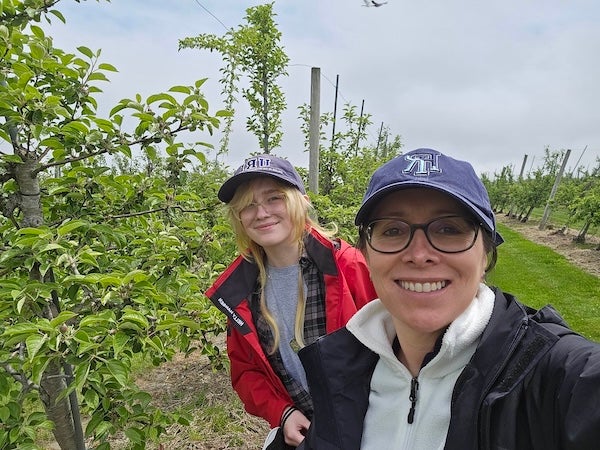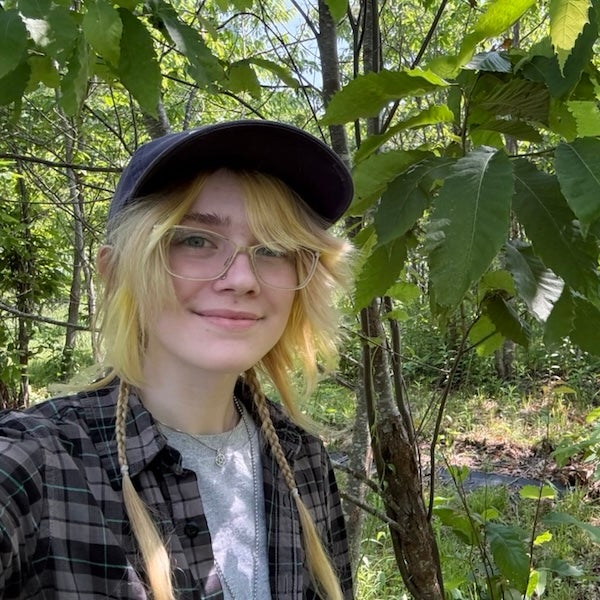Lou Cabrera, an environmental science and management major and restoration science minor from Piermont, New York, completed their CELS Summer Research Fellowship working with the Plant Diagnostic Laboratory, which operates via URI’s Cooperative Extension. Working under the direction of Dr. Keiddy Urrea-Morawicki, Cabrera assisted with the diagnosis of plant pathogens submitted to the lab, supported the lab’s outreach and education efforts, and helped write lab protocols for diagnoses. In this Q&A, Cabrera shares their experiences and highlights from the fellowship.
Q: Why did you choose this particular fellowship?
A. I am incredibly interested in the health of Northeastern forests and ecological change. I grew up being taught that stewardship of our environment was a responsibility, and that shaped my research interests. The impact of climate change on forests means that new pathways are opening for invasive species to expand their ranges northwards. Additionally, humans can act as a vector for these pathogens. This was the case of Chestnut Blight, as it was brought to the US from a shipment of Japanese Chestnut nursery stock imported from Asia. Climate change, through changes in precipitation and temperature, also stresses trees, which increases their vulnerability to new pathogens. All of this impacts our critical natural ecosystems, important forest habitats, and lumber operations. I hope to conduct research that allows us to gain a better understanding of these changes and what can be done to mitigate the consequences. The Plant Diagnostics Laboratory fellowship allowed me to gain a deeper insight into what it means to be a plant steward.
Q: What were your duties for the fellowship?
Day-to-day, the lab receives sick plants from farmers, homeowners, landscapers, state agencies, and anybody else in Rhode Island who has a plant health problem. Upon the sample’s arrival at the lab, it is logged into the lab management system, and the triage process begins. We observe the major symptoms, and then use microscopy to look for the pathogens structures, such as fruiting bodies. If no structures are present, they’re placed in a moist chamber or cultured to encourage their growth. These structures are all unique, and we use these differences to identify them.

During the summer, besides my CELS fellowship research project and the day-to-day operation of the lab, I supported the lab with other activities. The Plant Diagnostic Laboratory also conducts outreach and educational activities, such as workshops, pest walks, field days, or farm visits. For these activities, with already existing education material created for the lab, I made an educational poster about common diseases on urban farms to be used on farms around RI. The plant diagnostic lab also collaborates with the Biocontrol Lab for insect identification. Over the summer, I also assisted with lab accreditation, and as of August 1st, the lab is successfully accredited!
For my fellowship research specifically, my major goal was to create lab protocols for the diagnosis of prevalent tree and forest pathogens. It’s important that we have protocols that are specific to our lab resources. My major goal pathogens were Verticillium Wilt, Dutch Elm Disease, Chestnut Blight, Oak Wilt, Anthracnose, and Beech Leaf Disease. First, I needed samples, which I found both from field surveying, and from receiving them after they were submitted to the lab for diagnosis. If the sample was taken during surveying, it was incredibly important that I had enough of the pathogen to work with, while also minimizing the amount of damage that was done to the tree. This was especially critical if the disease was vascular. I experimented with different extraction methods, and how much of the tissue I really needed in order to identify and diagnose the pathogen. After the samples were collected or submitted, I would triage them, view their structures under the microscope, and then culture them. During culturing, the sample needs to be as clean as possible to ensure there isn’t growth of saprophytic (secondary) pathogens. I experimented with cleaning the vascular samples in an ethanol solution, as well as how long the samples needed to be submerged in a bleach solution.
As of right now I have collected samples and plan to write protocols for Anthracnose, Beech Leaf Disease, and Chestnut Blight. The Plant Diagnostics Lab has also recently received a new testing mechanism that is used for the molecular identification of Oak Wilt that I plan to write a protocol for.
Q: What challenges did you encounter during your fellowship?
The most challenging part of my project was being almost entirely dependent on submitted samples. I only really worked with pathogens that were submitted to us, which were mainly from crop and garden plants. While I did some surveying around campus to find tree pathogens I could work with (with the help of URI Lands and Grounds manager Paul Neri), none of them were pathogens I was hoping to write protocols for. While I waited for prevalent pathogens to be submitted, I validated our existing diagnostic processes for 10+ local tree pathogens, such as Setomelanomma holmi. I plan on using the materials I gathered from that to write protocols for future employees with little experience in plant pathology to use when entering the lab.
Q: What were some highlights of the experience?
I really enjoyed that in plant pathology, you are always learning. Especially when you’re just starting out – there’s a huge variety of plant species you’ll need to diagnose, and they’ll all have their own common pathogens you’ll need to learn, but those pathogens can present themselves in hundreds of different ways. Even later on, there are always going to be new diseases and new techniques you need to stay updated on. It can be difficult to keep up with, but also really fun. Diagnosis feels a bit like solving a puzzle, and it’s really satisfying when I can put the pieces together. Also, I really liked growing fungi on media plates. They can have such beautiful growth patterns and colors, which I can appreciate as an artist!
Q: How did the fellowship enhance your academic studies?
My fellowship deepened my passion for learning and research, and my critical thinking skills have improved. I feel like it’s easier to apply myself in class, now that I’ve had hands-on experience. Socially, I have better communication skills when interacting with my professors and peers.
Q: Any advice you’d like to share with students hoping to pursue fellowships?
Try everything! You’ll never know what sparks passion if you don’t. Don’t let bad experiences stop you from trying new, fun opportunities. Have confidence in your capabilities. You probably know more than you think you do.
This Q&A was organized by by CELS Communications Fellow, Yvonne Wingard

